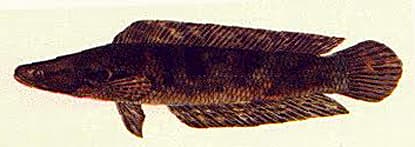Forest Snakehead – Channa Lucius – Thai Fish Species
Species: Channa Lucius
Common name: Forest snakehead or Splendid Snakehead. Thai Name: Pla Ka Song
Distribution: found throughout Asia, in Thailand, Japan, southern China, Vietnam, Taiwan and in the Philippines.
Habitat: Forest snakehead are known to occupy both natural and man-made bodies of water. Often found in slow-moving or stagnant waters within forested regions. They prefer the quieter sections of rivers and streams; they are highly adaptable and can also inhabit ponds and lakes within forested areas. Wetlands and floodplains, especially during the wet season when these areas become inundated with water. They use these habitats for feeding and reproduction. In some cases, Forest Snakehead have adapted to reservoirs and dams, which may have been created by humans for various purposes. They can thrive in these artificial habitats if they offer suitable conditions. Especially areas with dense vegetation, submerged roots, and overhanging branches. These habitats provide them with shelter and hiding places.
 Forest Snakehead (Channa Lucius)
Forest Snakehead (Channa Lucius)
Is a smaller member of the Channidae Snakehead family of fish, which are an extremely aggressive predatory fish species. It can breathe air which allows the species to survive in moist conditions outside of water over long periods. Like other Snakehead species, it has an elongated, cylindrical body with a snake-like appearance. A Forest Snakehead is well camouflaged, covered in a brown fine mesh-like scaling which displays two rows of dark colored blotches on its lateral surface, and have a large broad head with short snout and are equipped with a hinged protractile mouth with extended lower jaw. A streamlined freshwater predator, which favors ambush attacks on its unsuspecting prey. They typically lie in wait, often partially buried in substrate or hiding among aquatic vegetation, until prey comes within striking range. They then use their sharp teeth and powerful jaws to capture and swallow their prey whole.
It’s important to note that Forest Snakehead are a highly invasive species in certain parts of the world, where they have established populations in non-native habitats. Their adaptability and ability to breathe air and tolerate a wide range of environmental conditions make them a concern in these areas, where they can negatively impact native ecosystems. In their native range, they play an important ecological role as predators, helping to control prey populations and contributing to the overall balance of their aquatic ecosystems.
Lifespan and Size
The lifespan of a Forest Snakehead can vary depending on several factors, including its environment, food availability, and overall health. In their native habitats, where conditions are suitable, this snakehead species can typically live for several years. On average, their lifespan in the wild is estimated to be around 5 to 7 years, although some individuals may live longer. In captivity, where they are provided with a controlled environment and optimal care, they can potentially live even longer. Some individuals in well-maintained aquariums have been reported to live for over a decade.
The size of a Forest Snakehead can vary widely depending on its diet, and environmental conditions. These fish are known to exhibit sexual dimorphism, which means that males and females may have different sizes and appearances. Adult snakeheads can reach lengths of up to 24 inches (60 centimeters) or more, with some individuals reported to grow even larger, possibly reaching 30 inches (76 centimeters) or more. However, the average size for adult forest snakehead in their native habitat is often between 12 to 18 inches (30 to 45 centimeters). The present world record is 2.05 kg (4 lb. 8 oz). Caught in the waters of Kenyir, Trenggarm, Malaysia, on June 19, 2010.
Diet
Forest Snakehead are a carnivorous fish species with a diet primarily consisting of other aquatic organisms. Their feeding habits can vary based on their age and the availability of prey in their habitat. When they are young, they primarily feed on small aquatic invertebrates. This may include tiny crustaceans, insects, insect larvae, and small aquatic worms. Juveniles have smaller mouths and are adapted to hunt and consume small prey items.
As they grow and mature, their diet expands to include larger prey items. Adult snakehead are opportunistic predators and will consume a variety of aquatic creatures. Their diet may include fish, frogs, amphibians, crustaceans, and even small mammals if they are available. They are known for their voracious appetite and can be quite efficient predators. In some cases, especially when prey is scarce, larger Forest Snakehead may exhibit cannibalistic behavior, consuming smaller individuals of their own species. This can occur in overcrowded or resource-limited environments.
Forest Snakehead Breeding Timeline
Like many other snakehead species, they exhibit breeding behavior that are influenced by environmental cues, including seasonal changes in water levels and temperature. In their natural habitat, they often breed during the wet season, which is characterized by rising water levels and increased rainfall. The wet season provides more suitable breeding conditions, as it floods various aquatic habitats, such as flooded forests, swamps, and floodplains. The male typically chooses a nest site in an area with thick surface vegetation. He constructs a nest by clearing away debris and vegetation from the surface where the eggs are laid. The female releases her eggs into the nest created by the male, and the male follows close behind to fertilize them. The eggs float on the surface and stick to each other.
After fertilization, both the male and female provide parental care. They guard the nest and protect the eggs from potential threats, including predators. The male is particularly vigilant in guarding the nest and ensuring that the eggs receive oxygenated water. The eggs typically hatch after a few days to a week, depending on water temperature and other environmental factors. The newly hatched fry has a yolk sac attached, which provides them with initial nourishment. The parents continue to protect the fry after hatching. Once the yolk sac is absorbed, the fry begins to venture away from the nest and feed on small aquatic invertebrates and zooplankton. They may also receive protection and guidance from their parents as they explore their surroundings. After the fry have grown to a certain size and become more independent, the parental care behavior gradually diminishes, and the adult snakehead return to their normal feeding habits.
Gender
Gender determination of Forest Snakehead fish can be challenging, especially when they are young and not sexually mature. However, as they reach maturity, some physical characteristics can help differentiate between males and females. In general, adult females tend to be slightly larger than males. Females may exhibit a more robust body shape and grow to a larger size compared to males of the same age. The most reliable way to differentiate Forest Snakehead is by examining the genital papilla. This is a small fleshy protrusion located just behind the anus. It is more pointed and elongated in males and rounder and less prominent in females. During the breeding season, males may exhibit more territorial and aggressive behaviors as they establish and defend their spawning sites.
Forest Snakehead Fishing method
Fishing for Forest Snakehead can be an exciting and challenging pursuit, as these predatory fish are known for their strong strikes and fighting abilities. The best fishing areas in the lake are usually water with weedy and growing vegetation. It is a species that also can be found far up in the rivers, where they like to hang out in the pools and the still water after the rapids.
Medium to heavy spinning or baitcasting tackle is typically used. Ensure your equipment can handle the weight and power of these fish. Use a strong and abrasion-resistant fishing line, such as braided line, as they are known to hide in submerged vegetation and structure, which can lead to line abrasion.
Live baitfish, such as shiners, sunfish, or other small fish, can be effective when fishing for snakehead. Rig live baitfish on a hook and cast them near potential snakehead hiding spots. topwater lures, soft plastic frogs, and swimbaits are popular choices for targeting snakehead. These fish are known for striking surface lures aggressively, so topwater presentations can be particularly exciting. When using topwater lures, create surface disturbances to attract snakehead. Jerk the lure or use a “walk-the-dog” retrieve to mimic the movements of injured prey.


 Forest Snakehead (Channa Lucius)
Forest Snakehead (Channa Lucius)